We will deal with information for towing a travel trailer that you will need to know in order to be safe and protect your life and property. Adding the weight and bulk of a trailer to your tow vehicle turns it into an altogether different animal to drive and maneuver. The various sections of this page should enable you to drive it with confidence. There is a lot of material here. I know it can be intimidating, but it is all important so you will be able to safely and efficiently tow your Travel Trailer.
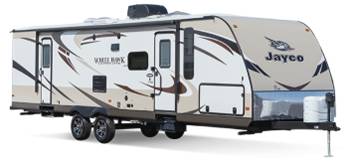
The Hitch You Will Need for Towing a Travel Trailer
We’ll start with the hitch receiver, the square tube under the bumper. These come in classes from I to V depending on how much weight you will be pulling. It’s a good idea to give yourself some safety room here and go heavier than your current truck. The receiver should also be welded to the frame of the tow vehicle with long weld beads, not just spot welded. Inside the receiver will be a steel bar with the hitch ball on one end. Make sure that your hitch ball is the same height as the trailer hitch. The trailer should ride evenly without a down or upward pitch. The maximum tongue weight should be 10 percent of the hitch rating. The hitch ball is rated for the total weight.

Safety chains should be crossed to form a saddle to hold the trailer up in case of failure of the hitch ball or other components. Don’t let them drag on the ground as they can be ground down and lose strength.
Now we’ll look at the trailer’s coupler. This connects the load(the trailer) to the hitch on the tow vehicle and must be able to handle the weight of your loaded trailer. The trailer hitch will work in many situations, but there are some excellent additions that will help distribute weight and prevent trailer sway. That is the “tail wagging the dog” action that sometimes happens.
A weight distributing hitch uses spring bars to help the installed hitch. They apply leverage to either side of the hitch, which transfers the load pushing down on the rear of the tow vehicle to the axles of the trailer. This provides a smooth, level ride and allows you to tow the maximum weight allowed.
A weight distributing system used the actual loaded tongue weight to determine which system to use. If the bars are rated too high, you will have a rigid ride and possibly bounce in your trailer. If they are not rated high enough, they won’t be able to distribute the weight and will not help at all.
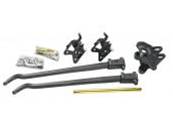
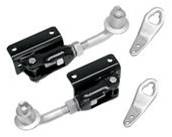
Sway-control devices are recommended for most weight-distribution systems. Trailer sway has several causes. Crosswinds, the load being too far back, and wrong spring bar tension in the weight-distribution system are the main ones. If your trailer starts to sway, most likely the trailer and tow vehicle haven’t been set up properly. The first thing is to not panic. Trailer sway usually starts gradually. As soon if it starts, slow down and let the vehicle slow without using the brakes. Once you’re down to a safe speed, carefully apply the brakes and stop. You can readjust the load or figure out why this happening.
No discussion of trailer hitches would be complete without mentioning the Hensley Arrow hitch. At around $3000, it is the Cadillac of hitches, but with good reason. To quote from company literature: “The Hensley Arrow uses a converging linkage system, which only allows the trailer to turn by forces applied by the tow vehicle and never by forces applied to the side of the trailer, such as wind or uneven roads. It works as a uni-directional tool.
Forces applied to the trailer must move the tow-vehicle and trailer together, making the vehicle and trailer perform like one solid unit. The tow vehicle, however, still maintains the ability to turn and control the trailer. It’s simple geometry, but it’s amazing what it does to completely eliminate trailer sway.”
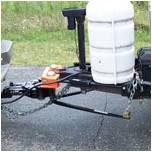
Hitching Up the Trailer
You will need to raise the tongue of the trailer a little higher than the hitch ball on the truck. Use the installed manual or electric jack to do this. Now back the truck up to the trailer SLOWLY so that the hitch ball is centered to receive the trailer coupler. When the receiver is directly above the hitch ball, put the truck in park with the hand brake on. Lower the trailer onto the hitch ball until it’s completely seated. Then flip the locking mechanism.
After the hitch is lowered onto the ball of the truck and latched on, the following sequence should occur.
- Using the tongue jack (electric hopefully) raise the tongue of the trailer back up, actually taking some of the weight of your tow vehicle. I’m not suggesting you pick the rear wheels off the ground, just add a few inches of height.
- Insert the WD spring bars (which each weigh as much as a couple of bowling balls) into the special head of the hitch stuck in the receiver of the tow vehicle.
- Using a trial and error method the first time, determine which link of the chain is the best choice to give the proper amount of torque in order to level out the tow vehicle and trailer tongue. Paint that link purple.
- Hook this link of the chain over the hooks on each side of the trailer tongue.
- Find the piece of pipe supplied with the hitch. (Usually mine can be found at the last campground we visited because I left it sitting on my bumper.) Now with all your might, using the pipe as a lever, lift up on the bracket until the hook and chain pop over center. Insert locking pin. (This is where lifting the tongue jack helps you out. Otherwise, you’d be lifting all that weight with your own strength).
This is a dangerous time. If your hand slips, that pipe will come flying back down at the speed of sound right before it breaks your arm in two or moves your jaw over about a foot and a half. Be careful!
Unhitching should follow the exact same procedure in reverse…. lift the tongue jack, use the pipe to flip down the chain hook. This part is even more dangerous because it’s hard to judge how much potential energy is stored up on the system. You can unexpectedly send that pipe into near earth orbit, break your jaw, or embed the pipe a foot deep into the back of your truck if you’re not careful.
This description is for the most commonly used setup. There are other slightly modified systems using various linkages, etc.that are slightly less life threatening.
Next, plug the trailer’s wires into the towing vehicle’s electrical outlet. The last thing is to attach the safety chains in a crisscross pattern, allowing enough slack for turns, but short enough to not drag. This is a great time to check that the truck and trailer lights are working properly as well as to test the trailer brakes.
NOTE: Many Thanks to Living the RV Dream podcast listener Jason Paulsel for the description of hooking up the equalizer bars. This is one reason I do not have a Travel Trailer.
Trailer Brakes, Tires, and Wheels
OK, you’re hooked up and ready for towing a travel trailer. Not so fast young Jedi. You must first ensure the trailer brakes are operational and able to stop the trailer in a straight line. Most Travel Trailers are equipped with electric brakes. They may be controlled with a surge device mounted on the trailer or remotely by a brake controller in your tow vehicle. Personally, I would opt for the truck mounted brake controller. Some less expensive trailers only have brakes on one axle. This could certainly be problematic in a panic stop. There are kits available to convert your brakes to electrically or surge activated disk brakes on all wheels. This would certainly be my preference when towing a travel trailer. Whatever setup you have, test it to ensure the trailer brakes actuate at the same time the tow vehicle’s brakes do.
While we’re talking about safety upgrades, now is the time to look at the tires. The air in your tires is all that holds up the load when towing a travel trailer. Special Trailer(ST) rated tires prior to 2010 that were of Chinese origin have had many problems and frankly are junk. Buy the best tires you can afford from a reputable company you trust. Get the highest load range that is available as well. Trailers have higher wheel loading than passenger cars or trucks. The axles do not steer, and the wheels are subjected to high twisting side loads in tight, slow turns. This causes the wheel to flex which tends to loosen wheel lug nuts over time. Check lug nut torque before each trip. A suitable torque wrench only costs about $30 and is a worthwhile investment considering the value of your trailer.
NOTE: The most common causes of tire failure are overloading and under-inflation. Both result in excess flexing of the sidewall which causes heat buildup and eventual failure. Continuing to run with a flat can cause it to catch fire.
Wheel lug nut torque is usually much higher than that specified for passenger car wheels. Check your particular trailer’s recommended specifications. Most are in the 90-95 ft.-lb. range. On a new trailer, check the torque on all wheels after the first 25-50 miles of towing. Also recheck any wheel that has been removed and replaced after towing 25 to 50 miles. Do not drive a loaded trailer with a missing lug nut or damaged lug bolt.
Your axle wheel bearings will need occasional attention. Feel with your hand at the hub to check for one that may be running hotter than the rest.
NOTE: If the bearing is adjusted too tight or is running without grease it can get VERY hot!
You must pay immediate attention to a hot bearing. They will either need more grease or adjustment, but replacement may be necessary.
Trailer Lights
Before towing a travel trailer, all the lights on the trailer must be connected through an umbilical cable to the tow vehicle’s light circuits. Trucks with towing option installed will have the connections already made and a receptacle for that cable someplace on the bumper. In addition to turn signal and brake lights, the trailer’s running lights must also come on when the tow vehicle’s lights are on.
Loading a Travel Trailer
Towing a travel trailer safely involves a careful loading process. The heavier items you load into the trailer should be placed as close to the middle as possible but first they must be tied down so they won’t shift while the trailer is moving. Start with the top heavy items. Lay them down and secure them. Arrange these items so they are protected in their location. Tying them down is not good enough. They need to be tied off at several angles or they could shift in a speed change. Your smaller items can act as filler material as long as they are securely fastened down.
Now is the time to start checking the tongue weight as you load. Sherline industries makes a great scale just for this and it is small and packable. They have models that will weigh up to 2000 pounds. Check them out on Amazon.com or direct from the manufacturer http://sherline.com/hydraulic-scales/. The smaller items can be loaded to help balance the load. Try to load the weight evenly from side to side as well. One side overweight can cause a serious problem when cornering, up to possibly turning over the trailer.
NOTE: Top heavy loads can cause trailer “dive” under hard braking, possibly reducing steering and braking control.
Do not put heavy things on add-on devices from the rear bumper or placed across the tongue frame. A bicycle is OK, but not much else.
Weighing the Tow Vehicle and Travel Trailer
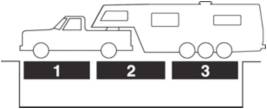
Now that you can tow and stop your trailer, it’s time to weigh it. Because so many RV’s are overweight and therefore unsafe, before towing a travel trailer, you should weigh it and your tow vehicle as soon as possible. You and your family’s life may very well depend on it as well as people on the road around you.
As with any towing situation, the very first thing you must do is determine if your towing vehicle has the capacity for towing a travel trailer fully loaded. That means full water tank, water heater, and propane tank. It also means all the gear you will carry on a typical trip. First thing to know is the tow vehicle’s towing capacity as well as rear Gross axle weight rating(GAWR). The very best way to determine if you are within rated limits is to weigh the rig all ready to go. First, enter the scale with only the front axle. Then the entire vehicle without the trailer. Circle around and hook up the trailer and weigh the tow vehicle with trailer attached. Next move forward until only the trailer is on the scale, and then move forward until only the rear axle is on the scale. You now have all the weights you need to determine your Gross Vehicle Weight, Your Tongue weight, and the total trailer weight as well as individual axle weights. All this information will tell you if either the tow vehicle or the trailer is overweight as well as the rear axle weight of the tow vehicle. With this you can also determine the proper air pressure to put in your tires according to the tire manufacturers tire loading charts for your particular model of tire.
What do you do if you are overweight? Oh, so many possibilities! If it is one or the other, you can move weight from one to the other. If your tow vehicle is very much overweight, you may need to consider a larger and more capable one. If the trailer is OK but heavier on one axle than the other, you will have to shift tat weight around. Bear in mind that 10 to 12 percent of the trailer’s weight should be on the tongue at all times. No more and no less.
Here is a YouTube video showing what can happen when you do not use weight distribution or sway control.
I hope this information on Towing a Travel Trailer will help you enjoy yours for a long time. We made this page to alert you to certain safety concerns with towing a Travel Trailer.
